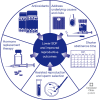Sperm DNA integrity and male infertility: a narrative review and guide for the reproductive physicians
- PMID: 35958895
- PMCID: PMC9360512
- DOI: 10.21037/tau-22-149
Sperm DNA integrity and male infertility: a narrative review and guide for the reproductive physicians
Abstract
Background and objective: Conventional semen analysis (SA) remains an essential tool in the initial male fertility evaluation and subsequent follow-up. However, it neither provides information about the functional status of spermatozoa nor addresses disorders such as idiopathic or unexplained infertility (UI). Recently, assessment of sperm DNA fragmentation (SDF) has been proposed as an extended sperm test that may help overcome these inherent limitations of basic SA. In this review, we aim to: (I) discuss the pathophysiological aspects of SDF, including natural repair mechanisms, causes, and impact on reproductive outcomes; (II) explain different assessment tools of SDF, and describe potential therapeutic options to manage infertile men with high SDF; and (III) analyse the strengths, weaknesses, opportunities and threats (SWOT) of current research on the topic.
Methods: This review was constructed from original studies, systematic reviews and meta-analyses that were published over the years up until August 2021, related to the various aspects of SDF.
Key content and findings: Different mechanisms lead to high SDF, including defective chromatin packaging, apoptosis, and seminal oxidative stress. The relevance of sperm DNA integrity to male fertility/infertility has been supported by the frequent observation of high levels of SDF in infertile men, and in association with risk factors for infertility. Additionally, high SDF levels have been inversely correlated with the outcomes of natural pregnancy and assisted reproduction. Terminal deoxynucleotidyl transferase dUTP nick end labelling, sperm chromatin structure assay, sperm chromatin dispersion, and Comet assay are four commonly used assays for measurement of SDF. Addressing lifestyle risks and underlying conditions, antioxidants, hormonal therapy, and advanced sperm selection techniques have all been proposed as potential therapeutic options to lower SDF.
Conclusions: The sum of literature provides evidence of detrimental effects of high SDF on both natural and assisted fertility outcomes. Standardization of the techniques used for assessment of SDF and their incorporation into the work up of infertile couples may have significant implications on the future management of a selected category of infertile men with high SDF.
Keywords: Assisted reproduction; male infertility; natural pregnancy; semen analysis (SA); sperm DNA fragmentation (SDF).
2022 Translational Andrology and Urology. All rights reserved.
Conflict of interest statement
Conflicts of Interest: All authors have completed the ICMJE uniform disclosure form (available at https://tau.amegroups.com/article/view/10.21037/tau-22-149/coif). The authors have no conflicts of interest to declare.
Figures



Comment in
-
The importance of incorporating sperm DNA fragmentation testing in male infertility diagnostic routine.Transl Androl Urol. 2022 Oct;11(10):1371-1373. doi: 10.21037/tau-22-572. Transl Androl Urol. 2022. PMID: 36386265 Free PMC article. No abstract available.
-
Elevated sperm DNA fragmentation levels result in detrimental effects on natural and assisted reproductive outcomes per a review of the medical literature.Transl Androl Urol. 2022 Nov;11(11):1484-1485. doi: 10.21037/tau-22-673. Transl Androl Urol. 2022. PMID: 36507492 Free PMC article. No abstract available.
-
State-of-art technologies to detect the DNA damage and repair in sperm and future outlook.Transl Androl Urol. 2023 Feb 28;12(2):148-151. doi: 10.21037/tau-22-870. Epub 2023 Feb 13. Transl Androl Urol. 2023. PMID: 36915881 Free PMC article. No abstract available.
Similar articles
-
Role of sperm DNA fragmentation in male factor infertility: A systematic review.Arab J Urol. 2017 Dec 6;16(1):21-34. doi: 10.1016/j.aju.2017.11.002. eCollection 2018 Mar. Arab J Urol. 2017. PMID: 29713533 Free PMC article.
-
Best laboratory practices and therapeutic interventions to reduce sperm DNA damage.Andrologia. 2021 Mar;53(2):e13736. doi: 10.1111/and.13736. Epub 2020 Jul 14. Andrologia. 2021. PMID: 32662555 Review.
-
A Strengths-Weaknesses-Opportunities-Threats (SWOT) analysis on the clinical utility of sperm DNA fragmentation testing in specific male infertility scenarios.Transl Androl Urol. 2017 Sep;6(Suppl 4):S734-S760. doi: 10.21037/tau.2017.08.20. Transl Androl Urol. 2017. PMID: 29082207 Free PMC article.
-
A systematic review on sperm DNA fragmentation in male factor infertility: Laboratory assessment.Arab J Urol. 2018 Jan 17;16(1):65-76. doi: 10.1016/j.aju.2017.12.001. eCollection 2018 Mar. Arab J Urol. 2018. PMID: 29713537 Free PMC article.
-
An update on clinical and surgical interventions to reduce sperm DNA fragmentation in infertile men.Andrology. 2020 Jan;8(1):53-81. doi: 10.1111/andr.12724. Epub 2019 Dec 9. Andrology. 2020. PMID: 31692293 Review.
Cited by
-
The importance of incorporating sperm DNA fragmentation testing in male infertility diagnostic routine.Transl Androl Urol. 2022 Oct;11(10):1371-1373. doi: 10.21037/tau-22-572. Transl Androl Urol. 2022. PMID: 36386265 Free PMC article. No abstract available.
-
Sperm DNA fragmentation in male infertility: From bench to bedside.Arab J Urol. 2023 Nov 23;21(4):199-203. doi: 10.1080/20905998.2023.2278200. eCollection 2023. Arab J Urol. 2023. PMID: 38178953 Free PMC article. Review.
-
Sperm DNA fragmentation testing in clinical management of reproductive medicine.Reprod Med Biol. 2023 Oct 31;22(1):e12547. doi: 10.1002/rmb2.12547. eCollection 2023 Jan-Dec. Reprod Med Biol. 2023. PMID: 37915974 Free PMC article. Review.
-
Sperm DNA Fragmentation Impairs Early Embryo Development but Is Not Predictive of Pregnancy Outcomes: Insights from 870 ICSI Cycles.Int J Mol Sci. 2025 Aug 16;26(16):7923. doi: 10.3390/ijms26167923. Int J Mol Sci. 2025. PMID: 40869243 Free PMC article.
-
Elevated sperm DNA fragmentation levels result in detrimental effects on natural and assisted reproductive outcomes per a review of the medical literature.Transl Androl Urol. 2022 Nov;11(11):1484-1485. doi: 10.21037/tau-22-673. Transl Androl Urol. 2022. PMID: 36507492 Free PMC article. No abstract available.
References
Publication types
LinkOut - more resources
Full Text Sources
